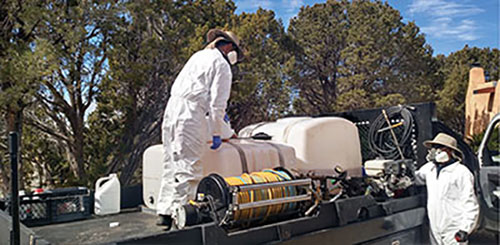Guide A-618
Leslie Beck, Amanda Skidmore, Phillip Lujan, Stephen Baca, and Nathan Abrahamson
College of Agricultural, Consumer and Environmental Sciences, New Mexico State University
Respectively, Extension Weed Specialist, Department of Extension Plant Sciences (EPS), New Mexico State University (NMSU); IPM Small Farm Specialist, Agricultural Science Center at Los Lunas, NMSU; Program Manager/Diagnostician, Plant Diagnostic Clinic, EPS, NMSU; Program Manager, New Mexico Department of Agriculture (NMDA) Pesticide Management Bureau; and Senior Inspector, NMDA Pesticide Management Bureau. (Print Friendly PDF)
Personal protective equipment (PPE) can be difficult to acquire during the COVID-19 public health emergency. PPE items normally available to pesticide applicators (e.g., N95 masks, nitrile gloves, Tyvek suits) are being redirected to essential medical personnel and first responders at high risk of exposure and illness. Some items are no longer available, and those that do make it to store shelves may be quickly purchased. This leaves a limited amount of PPE available to pesticide applicators. Many pesticides (herbicides, fungicides, insecticides, etc.) require applicators to wear PPE during application, or when working in areas that have been recently sprayed, to be in compliance with the product’s labeled directions/restrictions. These items are essential for applicator safety, which should be of upmost importance whenever handling chemical products.
In this guide, we hope to provide a few considerations and measures that can be taken when choosing alternative yet still appropriate PPE, along with suggestions for cleaning, storage, and care that can help prolong the use of essential PPE while still being within the safety guidelines described on product labels. Remember that it is important to communicate with employees who may be in need of PPE or exposed to a pesticide application.
Note: If you are tank-mixing pesticides, you must follow the most restrictive pesticide label language when selecting gloves and other PPE.

Photo by Stephan Baca.
Respirators
One of the most difficult and limited forms of PPE to acquire are specific types of masks and respirators, such as dust masks and N95 classified masks and respirators. Since most new shipments and supplies of these types of PPE are reserved for medical workers, pesticide applicators will be at a great risk of not having access to proper PPE. Respirators should not be replaced by creating your own version of a mask because these homemade alternatives will not meet the standards of protection needed to keep you safe while applying a pesticide as defined by the directions in the product label.
The best way to circumvent the need for a respirator in the first place is to consider the applicability and effectiveness of alternative pesticides that do not require the use of a respirator according to the label instructions. Multiple universities and Extension programs are working to update an open access list of various pesticides and their respirator requirements for application. Please refer to the links below for examples of these types of lists. These websites are a good start, but be sure to read the label to be certain the information is still applicable because labels change all the time. It is also important to note that not all products are approved for use in every state, so check with your state-approved uses.
- Michigan State University Extension: https://www.canr.msu.edu/news/vegetable_pesticide_series_does_it_require_a_respirator
- Oregon State University: https://agsci.oregonstate.edu/oipmc/pesticide-risk-reduction-low-risk-pesticide-list
If there is an option for a pesticide that will achieve the equivalent amount of pest control and can be applied in the same location/situation without the need of a respirator, it is advisable to switch to these alternatives during this respirator shortage. It is recommended that you read the label of any pesticide you may select prior to application, especially if you are unfamiliar with the product. Specifically, applicators should note any changes to re-entry intervals (REI) and post-harvest intervals (PHI) and communicate these changes to homeowners and/or employees who may come in contact with the treated area or crop.
If you do have access to a respirator, you must determine how and when the labeled directions instruct you to wear your PPE. For example, the label might direct the applicator to wear a respirator while measuring and mixing the pesticide, and/or when making applications. In these situations, it is vitally important to make sure that you are wearing your respirator correctly. Many resources are available for the proper use of respirators, dust masks, and N95 masks:
- Video tutorial: https://www.youtube.com/watch?v=b3aEY52et7k
To extend the life of your respirator, it is important to maintain, clean, and store your respirator appropriately. If the label instructs that a respirator is needed during a specific re-entry timeframe into the sprayed area following an application, it might be effective to restrict access within this area during the REI timeframe to prolong the integrity of your respirators.
Disposable Gloves
Respirators aren’t the only PPE in demand during this shortage; single-use disposable gloves are also being reserved for essential workers, especially medical personnel. The good news for pesticide applicators is that there are a number of other re-useable glove options available in materials such as neoprene, butyl, barrier laminate, and Viton. Some pesticide labels may specify the exact type of glove to be used, while many labels only indicate the general type of glove, like waterproof or chemical resistant.
No matter what type of re-useable glove you select (based on label language), proper maintenance is important to minimize contamination and prolong their use. For example, it is important to properly and effectively clean these gloves (https://extensionpublications.unl.edu/assets/pdf/g1961.pdf) prior to removing them and other types of PPE. Why is this important? Pesticide residues from the outside of the gloves can easily be transferred to hands, clothes, and other items during removal and storage, leading to cross contamination onto spray equipment, the outside and inside of work trucks, personal vehicles, homes and landscapes, and personal clothes, which can lead to further contamination within the applicator’s home and expose their families as well. Proper storage of these gloves (away from other PPE, potential contaminants, sunlight, etc.) will help prolong their safe usage as long as possible.
Protective Coveralls (e.g., Tyvek, etc.)
Protective coveralls are also in limited supply. Just like with respirators, it is worth considering alternative pesticide options that will provide comparable pest control without the need for specific coverall attire, such as disposable Tyvek suits. Additionally, it is possible to remove Tyvek suits without damaging them, and to clean the outside between each use to prolong the life of one suit in the midst of a shortage. However, it is essential to follow the proper protocols (https://cropwatch.unl.edu/tips-washing-pesticide-contaminated-clothing-unl-cropwatch-august-24-2011) for effective cleaning and drying of the outside of the suit/clothes to prevent potential cross contamination between applications and during storage. In the process of drying clothing or protective coveralls, it is often suggested to hang-dry them on a clothesline in full sun to allow for a more effective breakdown of potential contaminants through photodegradation. Be careful when hanging or storing coveralls to reduce exposure to yourself, coworkers, family members, and others.
- Purdue University Extension: https://www.purdue.edu/dffs/beginningfarmers/links/pesticides-and-personal-protective-equipment-selection-care-and-use/

Photo by Nathan Abrahamson.
Integrated Pest Management
It is certainly worth considering alternative management options to pesticides, particularly in the midst of an essential PPE shortage for applicators. To effectively manage any pest (weeds, plant pathogens, insects, etc.), success is increased when combining different management practices (e.g., mechanical, physical, preventive, cultural, biological), which is the foundation of any integrated pest management (IPM) program. Developing a management strategy based on IPM principles (https://aces.nmsu.edu/ipm/) can reduce the need for pesticide use and save money for applicators, producers, and homeowners.
Even when there is an abundance of available PPE for pesticide applications, utilizing a strong IPM program will help to provide effective pest control in a safe and sustainable manner. This may be a daunting endeavor for an applicator unfamiliar with IPM, but NMSU has many resources to help you begin adopting best management practices. Increasing our pesticide use efficacy will become important as access to certain products may become limited in the future.
- EPA School IPM: https://www.epa.gov/managing-pests-schools
Do-it-yourself Alternatives
In the midst of a commodity shortage, it is not unusual to see multiple suggestions for do-it-yourself (DIY) mixtures and materials online and on social media. Recent examples of DIY alternatives in light of the recent global pandemic include home-made mask and respirator alternatives, ranging from cloth masks with pockets for filters to old clothes or scarves around your face; homemade soaps and hand sanitizers; and alternative options for materials that can replace disposable nitrile gloves, just to name a few. It is important to realize when making pesticide applications that the label is the law, and label directions are based on professional, research-based recommendations for what is required to remain safe. Outside of these professional recommendations, it is unknown if these alternatives will be effective in protecting you against pesticides or harmful diseases. When used or mixed improperly, DIY equipment and mixtures can have the potential for serious injury and cause unintended off-target harm. When in doubt, the label is the law, and therefore must always be followed for safe, successful, and sustainable applications and pest control.
For Further Reading
A-610: Extension Pesticide Applicator Training Series #1: Pest Identification
https://pubs.nmsu.edu/_a/A610/
A-611: Extension Pesticide Applicator Training Series #2: Pest Management Practices
https://pubs.nmsu.edu/_a/A611/
A-612: Extension Pesticide Applicator Training Series #3: Treatment Area Measurements
https://pubs.nmsu.edu/_a/A612/

Leslie Beck is the Extension Weed Specialist at New Mexico State University. Her research program focuses on integrated weed management systems in landscape, horticultural, and agronomic crops. Her Extension work provides the citizens of New Mexico with accurate, applicable, and effective weed identification and management strategies in multiple cropping systems.
To find more resources for your business, home, or family, visit the College of Agricultural, Consumer and Environmental Sciences on the World Wide Web at pubs.nmsu.edu.
Contents of publications may be freely reproduced, with an appropriate citation, for educational purposes. All other rights reserved. For permission to use publications for other purposes, contact pubs@nmsu.edu or the authors listed on the publication.
New Mexico State University is an equal opportunity/affirmative action employer and educator. NMSU and the U.S. Department of Agriculture cooperating.
June 2020 Las Cruces, NM


